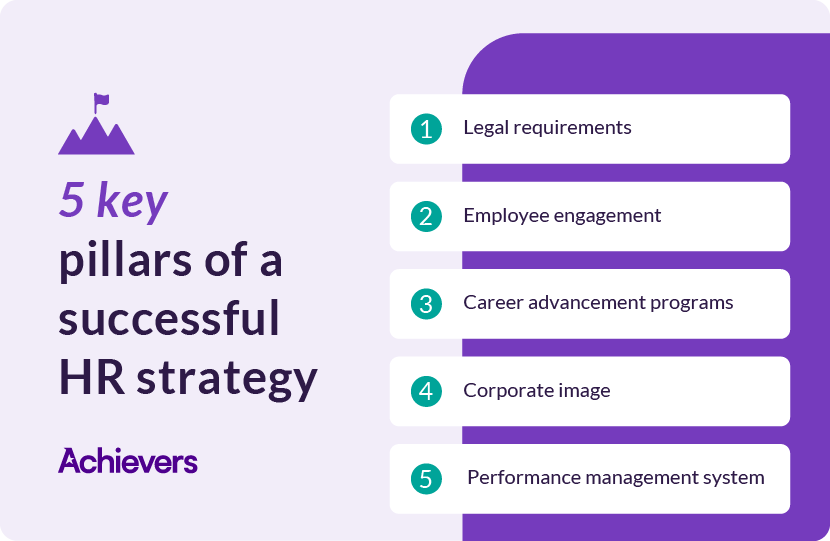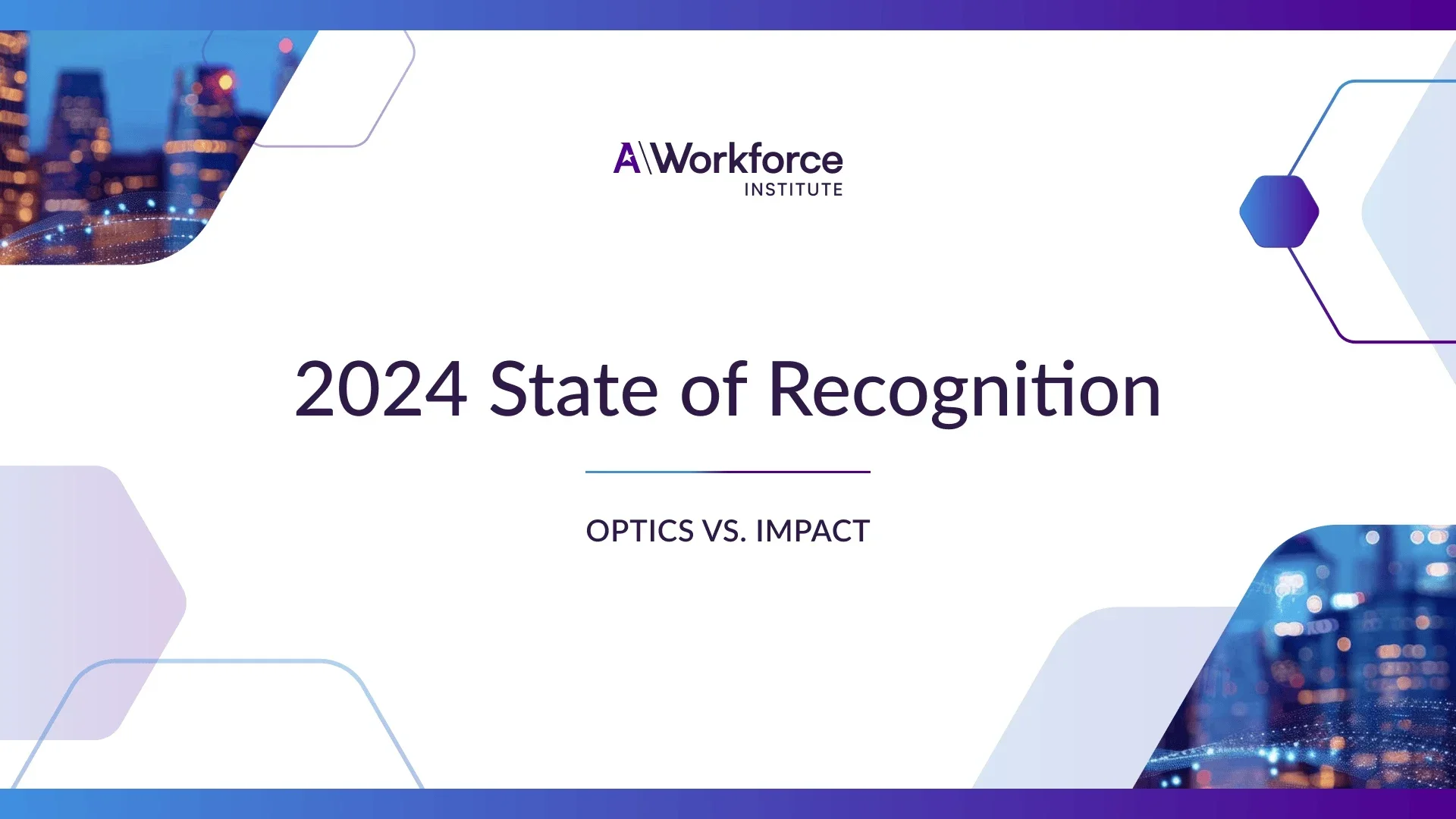Table of contents
How successful is your current HR strategy? The role of the HR department has evolved over the years, transitioning from the traditional “hire and fire” arm of the business to a strategic position. Today, HR departments are not only responsible for recruiting new talent and onboarding employees, but also establishing a positive workplace culture and environment.
Juggling traditional responsibilities with the demands of being an HR professional in today’s workplace can be challenging. When trying to meet the needs of the business and its employees, important details can often be overlooked. To address these complexities and ensure a comprehensive approach, it’s crucial to focus on the foundational elements.
What are the 5 key pillars of a successful HR strategy?
These pillars serve as the bedrock for an effective and dynamic HR strategy, guiding organizations to not only meet but exceed their strategic goals. By understanding and implementing these core elements, HR departments can create a robust strategy that balances traditional responsibilities with modern demands, ensuring the organization thrives. Let’s explore these five critical pillars in detail:

1. Legal requirements
When onboarding an employee, it’s crucial to follow and fulfill all legal requirements to ensure the protection of both the business and the employee. Legal compliance is essential to avoid penalties and foster a fair and safe work environment.
The importance of legal requirements
Adhering to legal requirements is essential for several reasons:
- Legal protection: Ensures that the business is protected from potential lawsuits and fines.
- Employee rights: Safeguards employees’ rights, promoting a fair work environment.
- Operational efficiency: Reduces the risk of disruptions due to legal issues.
- Reputation management: Enhances the business’s reputation by demonstrating commitment to lawful and ethical practices.
- Workplace safety: Ensures a safe and healthy working environment, which is crucial for employee well-being and productivity.
Examples of legal requirements around the world
Below is a list of key legal requirements for employee onboarding, including the U.S., U.K., Canada, Singapore, and Australia:
U.S. legal requirements
- W-4 form: This form is used by employees to indicate their tax situation.
- I-9 form: This form verifies the identity and employment authorization of individuals hired for employment in the United States.
- Workers’ compensation: Mandatory for all businesses, ensuring that employees receive medical care and compensation for work-related injuries and illnesses.
- Directors and officers insurance: Protects the personal assets of directors and officers in the event they are personally sued for wrongful acts.
- General liability insurance: Provides coverage for legal issues due to accidents, injuries, and claims of negligence.
UK legal requirements
Employment contract: Employers must provide a written statement of employment particulars within two months of the employee’s start date.
- P45 form: Given to employees when they leave a job, detailing the amount of tax paid during the tax year.
- P60 form: End-of-year certificate showing the total pay and tax deductions.
- Right to work check: Employers must check that job applicants are allowed to work in the UK before they start work.
- Health and safety: Compliance with the Health and Safety at Work Act 1974, ensuring a safe working environment.
Canadian legal requirements:
- Social Insurance Number (SIN): Employees must provide their SIN for tax and employment purposes.
- Employment contract: Must include details such as job description, salary, work hours, and other terms of employment.
- Canada Pension Plan (CPP) and Employment Insurance (EI): Employers must make contributions to CPP and EI on behalf of their employees.
- Provincial health and safety regulations: Compliance with health and safety regulations, which vary by province but generally ensure a safe working environment.
- Workplace Hazardous Materials Information System (WHMIS): Employers must provide training and information about hazardous materials in the workplace.
- Workers’ compensation: Employees must be compensated for work-related injuries and illnesses.
Singapore legal requirements
- Employment Pass (EP): Necessary for foreign professionals, managers, and executives to work in Singapore.
- CPF contributions: Central Provident Fund contributions for Singaporean citizens and permanent residents.
- Employment contract: Must include key employment terms such as salary, working hours, and job responsibilities.
- Workplace Safety and Health Act (WSH): Ensures that employees have a safe and healthy work environment.
Australian legal requirements
- Fair work information statement: Must be provided to all new employees, detailing their rights and conditions of employment.
- Tax File Number (TFN) declaration: New employees must provide their TFN to their employer for tax purposes.
- Superannuation: Employers must make regular superannuation contributions to their employees’ retirement funds.
- Work Health and Safety (WHS) Act: Ensures that workplaces adhere to health and safety regulations.
2. Employee engagement
Employee engagement is critical to a company’s success. After all, an engaged employee is a productive one. Engaged employees tend to show higher levels of commitment and motivation, leading to better performance and innovation. Additionally, they often exhibit greater job satisfaction and a stronger sense of loyalty to the company.
All this often leads to increased employee retention — a natural outcome of engagement. When employees feel valued, supported, and connected to their work and organization, they are less likely to seek opportunities elsewhere. This stability not only saves the company money in recruitment and training costs but also helps maintain institutional knowledge and fosters a cohesive work environment.
How to improve employee engagement
To increase employee engagement, bring the following into your culture and HR strategy:
- Gamification: Incorporate gamification into employee activities, such as achievement-tracking and peer competition, to infuse elements of fun and motivation into everyday tasks. By integrating game-like mechanics such as points, badges, and leaderboards, organizations can incentivize participation, foster collaboration, and drive productivity among employees.
- Rewards: Financial and non-financial incentives, such as rewards and recognition, give employees something to work toward. In addition, they reinforce attitudes and behaviors that will help the organization succeed. You can make the process of tracking these incentives, and the milestones that designate them, with an employee recognition and engagement platform such as Achievers.
- Recognition: Employee recognition software, like Achievers Recognize, enhances engagement by acknowledging and validating employees’ contributions, fostering a sense of value and belonging within the organization through a structured recognition program.
- Employee surveys: Regular surveys, facilitated by employee feedback software like Achievers Listen, not only highlight areas for improvement but also make employees feel their input drives positive change, boosting engagement and morale.
3. Career advancement programs
An organization’s biggest and most precious investment is its employees. Yet, many organizations don’t invest enough in the development of their employees. A career advancement program helps sustain employee engagement, as employees are given the opportunity to progress both personally and professionally.
In addition, employee development helps nurture talent within the organization, reducing the time and costs associated with hiring outside employees.
A successful career advancement program should help employees set achievable goals and offer in-house training sessions. Toastmasters International, for example, is a communication and leadership development program that teaches employees to become more effective communicators.
Types of career advancement programs
Here are just a few career advancement programs aimed at empowering employees and facilitating their professional development journey within organizations:
- Mentorship programs: Pairing employees with experienced mentors who provide guidance, support, and career advice.
- Leadership development programs: Offering training and workshops to cultivate leadership skills among employees, preparing them for higher-level roles.
- Skill enhancement programs: Providing opportunities for employees to develop specific skills relevant to their current or desired roles through workshops, courses, and certifications.
- Cross-training initiatives: Offering employees the chance to gain experience and knowledge in different departments or roles within the organization.
- Succession planning programs: Identifying high-potential employees for future leadership positions to ensure continuity and smooth transitions within the organization.
- Tuition reimbursement programs: Supporting employees’ pursuit of higher education or professional development by reimbursing tuition costs for relevant courses or degrees.
- Career path initiatives: Helping employees visualize and plan their career trajectory by providing clear paths for advancement and opportunities for growth.
4. Corporate image
A strong corporate image is crucial for attracting top talent. A reputable brand not only appeals to job seekers actively seeking opportunities but also catches the attention of passive candidates. HR departments play a vital role in maintaining and promoting this image, effectively communicating the organization’s values and culture to prospective employees.
A compelling brand narrative enhances the employer value proposition, making it easier to attract skilled individuals who align with the company’s goals and aspirations. Overall, a strong brand presence significantly aids in employee acquisition efforts, contributing to the organization’s long-term success.
How to enhance your corporate image
Enhancing your corporate image involves a thoughtful examination of various aspects of your organization. Consider the following areas of improvement to guide your efforts:
- Alignment of branding and company culture: If your branding emphasizes innovation, it’s crucial to ensure that your company culture reflects this value. Are employees encouraged to think creatively and contribute ideas? Is there a culture of experimentation and risk-taking that fosters innovation? Assessing the compatibility between your brand messaging and internal practices can strengthen your brand’s authenticity and appeal.
- Integration of branding with technological advancements: If your branding campaigns highlight technology, it’s essential to evaluate whether your staff has access to the latest equipment and tools. Are employees equipped with state-of-the-art technology that enables them to perform their tasks efficiently and effectively? Investing in cutting-edge technology not only enhances productivity but also reinforces your brand’s commitment to progress and advancement.
- Social media representation: Assess how your company is portrayed on social media platforms, both through official company channels and individual employee profiles. Are your social media accounts actively engaging with followers and sharing content that aligns with your brand values? Additionally, consider the online presence of your employees — do they embody the brand image and contribute positively to its perception? Monitoring and curating social media content can help maintain a consistent and favorable portrayal of your organization.
5. Performance management system
To make goal-setting successful, you need to have a tracking system in place. Without an advanced performance management system, it’s difficult for employees to gauge their progress and stay motivated in reaching their goals. Not to mention, keeping track manually can get messy and is less reliable.
Human Resources Information Systems (HRIS) play a crucial role in organization success. These integrated software solutions streamline various HR functions, including performance evaluation, feedback mechanisms, and key objectives or goal tracking. By leveraging HRIS, organizations can automate tedious administrative tasks, reduce human error, and provide real-time insights into employee performance.
If you haven’t yet, consider investing in a performance management system that makes it easy for employees and managers to track and measure progress throughout the year. If you have trouble getting buy-in from decision makers, ask for a free 30-day trial of the product you like most. When your trial is up, you can show higher-ups the benefits, rather than tell.
Why performance management systems matter
Investing in a robust performance management system is essential for achieving key organizational objectives. Here are several ways an advanced system can benefit your business:
- Enhanced communication: Performance management systems facilitate regular communication between employees and managers. Through ongoing feedback and check-ins, employees can align their efforts with organizational goals and address any performance gaps in a timely manner.
- Goal alignment: Aligning individual goals with key objectives is essential for driving overall productivity and efficiency. Performance management systems enable employees to set SMART (Specific, Measurable, Achievable, Relevant, Time-bound) goals and track their progress effortlessly.
- Performance evaluation: Conducting fair and objective performance evaluations is critical for recognizing employee contributions and identifying areas for improvement. Performance management systems provide a structured framework for conducting evaluations based on predefined criteria, ensuring consistency and transparency across the organization.
- Employee development: Continuous learning and development are key objectives for fostering employee growth and engagement. Performance management systems facilitate personalized development plans, training opportunities, and skill assessments to support employees in reaching their full potential.
- Data-driven insights: Leveraging data analytics capabilities, performance management systems offer valuable insights into workforce trends, performance patterns, and areas of strength and improvement. These insights empower HR professionals and decision-makers to make informed strategic decisions that drive organizational success.
Be a modern HR professional
A successful HR strategy hinges on five key pillars: legal compliance, employee engagement, career advancement, a strong corporate image, and an effective performance management system. By focusing on these elements, HR departments can balance traditional responsibilities with modern demands, fostering a thriving workplace.
HR software plays a vital role in supporting these pillars, but the pricing of an HR software varies based on factors like features, company size, and deployment model. Whether choosing a subscription-based cloud solution or a one-time licensing fee, businesses need to balance cost with functionality. Scalable pricing models ensure companies can invest in the right tools without exceeding their budget while adapting to workforce growth.
The Achievers Employee Experience Platform™ supports HR professionals in implementing these pillars seamlessly. With tools for employee recognition, feedback, rewards, and more, Achievers helps create a positive workplace culture and enhance engagement.
Explore how the Achievers platform can transform your HR strategy into a powerful force for organizational success by booking a demo today.



